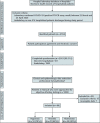Loss of Smell and Taste in 2013 European Patients With Mild to Moderate COVID-19
- PMID: 32449883
- PMCID: PMC7505100
- DOI: 10.7326/M20-2428
Loss of Smell and Taste in 2013 European Patients With Mild to Moderate COVID-19
Figures

References
-
- Rodriguez-Morales AJ, Cardona-Ospina JA, Gutiérrez-Ocampo E, et al; Latin American Network of Coronavirus Disease 2019-COVID-19 Research (LANCOVID-19). Clinical, laboratory and imaging features of COVID-19: a systematic review and meta-analysis. Travel Med Infect Dis. 2020;34:101623. [PMID: 32179124] doi:10.1016/j.tmaid.2020.101623. - PMC - PubMed
-
- Hummel T, Kobal G, Gudziol H, et al. Normative data for the “Sniffin' Sticks” including tests of odor identification, odor discrimination, and olfactory thresholds: an upgrade based on a group of more than 3,000 subjects. Eur Arch Otorhinolaryngol. 2007;264:237-43. [PMID: 17021776] - PubMed
Publication types
MeSH terms
LinkOut - more resources
Full Text Sources
Medical
